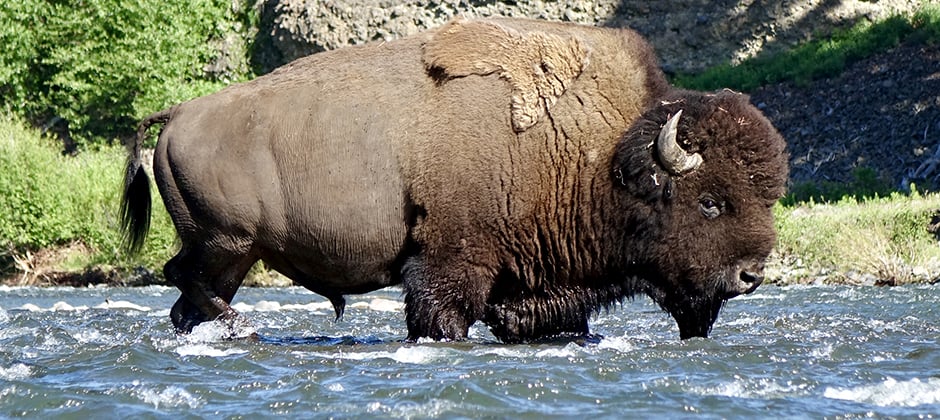Share this article
Q&A: Wildlife can help the phosphorus crisis
Phosphorus is a key ingredient in fertilizer, but this resource is running out. That’s because most of the phosphorus used for agriculture is mined from a finite source of mineral-rich rocks, which leaches from farms into the ocean where it is eventually buried in deep sediments. Historically, however, wildlife species such as whales, seabirds and fish helped transport phosphorus back to land through their excrement and carcasses. Terrestrial species such as bears, bison and elephants further redistributed this element, increasing the overall fertility of the planet. But as wildlife populations have declined, so have their roles in transporting phosphorus.
In a study published in Science of the Total Environment, Andrew Abraham, a postdoctoral researcher at Northern Arizona University, and his co-authors examined how wildlife can be used to confront the phosphorus crisis by revitalizing the natural phosphorus pump.
We connected with Abraham to learn more about the role of wildlife in phosphorus recovery. The interview is edited for style and brevity.
How has wildlife historically transported phosphorus?
Phosphorus is essential for all ecosystems across the planet. Plants need it. Animals need it. When animals eat, they assimilate phosphorus from their diet and use it to grow. For vertebrate species, most of this phosphorus is, in fact, used to build their skeletons. When animals move across landscapes, they redistribute phosphorus from one place to another in their bodies, urine and dung.
There are a lot of studies that have examined wildlife-mediated pathways of phosphorus transport. In our study, we collated them together to look at how whole communities of wildlife transport phosphorus. Due to their high consumption, long gut passage time and large daily movement ranges, large animals such as elephants and whales can be thought of as the planet’s nutrient arteries dispersing phosphorus over long-distances. Small animals and scavengers such as dung beetles and hyenas are then the nutrient capillaries, recycling phosphorus locally. Collectively, wildlife can therefore move phosphorus from where it is concentrated into other ecosystems where it’s lacking.
Why is phosphorus now hard to come by?
Phosphorus is largely mined from phosphorus-rich rocks, which are only found in a few places across the world. As it’s an essential ingredient for fertilizer, it’s liberally applied to farmers’ fields. Unfortunately, much of the phosphorus added to fields leaches into rivers, where it’s carried to the ocean and into a really dispersed form. Like this, it is effectively unrecoverable with current technologies. As the easily accessible deposits of phosphorus-rich rock become rarer, there are now genuine concerns that we might run out of this essential element over the coming centuries.
What role does wildlife play?
In our paper, we outline four clear ways in which animals help retain phosphorus in the biosphere. The first way is upstream movement, whereby animals including whales and fish move phosphorus from the bottom of the ocean against gravity back toward land.
Second, is aquatic-to-terrestrial movement, with wildlife connecting the oceans and the land. This group includes seabirds, bears and turtles. They’re eating marine food, but often defecate or leave phosphorus-rich organic material on the land.
Third, is lateral redistribution. This included for example, the movement of phosphorus from a nutrient-rich river floodplain to upland regions. All animals, from insects to elephants, are important in this process.
The last mechanism is retention. Animals such as beavers engineer ecosystems in ways which help to retain phosphorus in the landscape. Similarly, bivalves like mussels and oysters filter phosphorus out of the water column and retain it within their bodies.
What did your models reveal about how this wildlife role has changed?
Much of our research revolves around modeling how different animal communities transport nutrients across land- and seascapes. Based on our models, it’s clear that human activities have had a major impact on the magnitude of phosphorus transport compared to 12,000 years ago.
In particular, the extinction and population reduction of the planet’s largest animals has led to a decrease in wildlife phosphorus transport by over 90%. Similarly, the erection of fences has further decreased the connectivity of ecosystems.
One of the arguments we make in the paper is that maybe the reason why we haven’t considered animals as important for phosphorus recycling before is because we live in a world where most ecosystems have lost most, or maybe all, of their large animals.
How do we begin to support this wildlife role and help address the phosphorous crisis?
We’ve currently got a world where some areas experience far too much phosphorus, which causes issues of eutrophication or nutrient pollution. In others, we have diminishing concentrations of this key resource. In general, it’s the human-dominated landscapes that have too much, while the ‘natural’ landscapes are losing phosphorus.
Our goal for this paper is to try and help conserve phosphorus at the global scale. Of course, it will take local efforts to address local phosphorus problems, but we believe that wildlife should be part of the conversation.
There are currently a number of important schemes already in place to try and recover and conserve phosphorus, such as wastewater management. If we restore wildlife communities to their historical baselines, our models suggest that the nutrient-retaining services of these animals can also make a valuable contribution to the global phosphorus budget. We based our idea on the current carbon trading system. In this way, some countries or localities may continue using mined phosphorus, but they pay for it to be conserved by biodiversity projects somewhere else. Implementing such schemes will of course be complicated, but given the substantial body of evidence we’ve found for the important role of wildlife in nutrient recycling, we hope our idea inspires others to think about more holistically about the future of phosphorus sustainability.
Header Image: Large mammals like bison (Bison bison) play can play an important role in moving phosphorus through the ecosystem. Credit: Andrew Abraham








